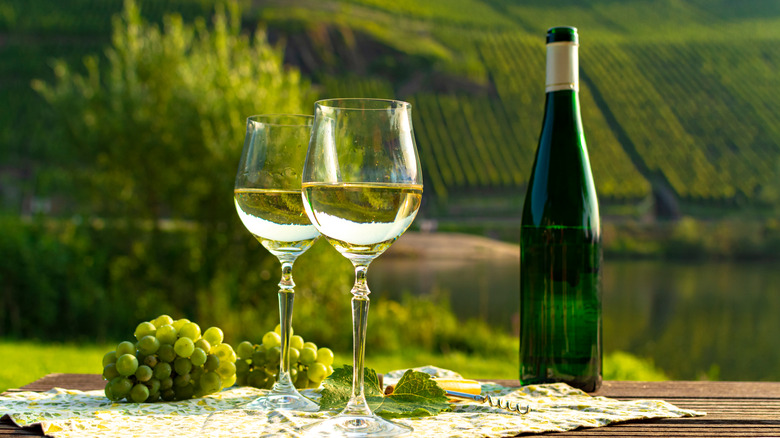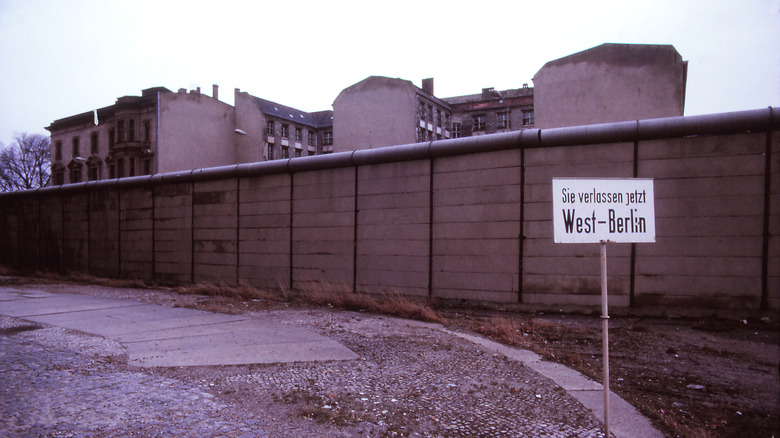How The Berlin Wall Impacts German Wine To This Day
Despite its close proximity to the powerful wine producers of France and Italy, Germany has never had much of a great reputation when it comes to wine. The colder, more northern climate is not exactly an intuitive choice for viticulture, and many grape varieties struggle to ripen in the region; some that do are marked by the intense acidity that accompanies grapes grown in cold climates. Aside from well-known varieties like Riesling and Gewürztraminer, German wine has not made much of an impact on the global oenological stage, maintaining an image as a producer of overly sweet and boring wines.
But much of Germany's wine trouble is due not to the climate itself, but rather to lost, or nearly lost, winemaking traditions in the region. After a late 19th century phylloxera outbreak in the region, followed by two World Wars, many wine regions struggled to recover in the midst of continuing political upheaval. In particular, Germany bore the brunt of the effects as the country was literally split into two by the Berlin Wall, with either side upholding different ideologies and points of access. Until the Wall fell in 1989, the division even impacted the country's wine production.
East and West Germany had different policies on wine-making
While France and Italy's wine regions were able to come back stronger in the second half of the 20th century, Germany didn't exactly have the same options, as the country had been cleaved in two by the Berlin Wall, with East and West Germany adhering to completely different laws and outlooks.
Unlike West Germany, which was more liberal and was able to uphold wine production, the socialist workers' state of East Germany forbid the private ownership of vineyards, with some historic winemaking families stripped of their property, either during Nazi rule, or after the state's foundation in 1949. Even prospective bootleggers were limited in their winemaking capacity by a lack of equipment and land.
Instead, large government-run cooperatives mass-produced wine with the intention of cranking out as much as possible, with little attention to taste. Grapes were planted willy-nilly depending on availability, and tended to by farmers without much vineyard experience. (Most of these growers weren't even allowed to make or purchase wine themselves as most went to "friends of the government," notes Wine Enthusiast.)
The grapes were then sold off to the co-ops, that would blend them en masse, without distinction, resulting in a single type of wine sold made with no attention to taste. Since only the wealthy and politically well-connected could get ahold of commercially-produced wine, some growers would make homemade wine in secret, which became a valuable black market commodity.
Germany's wine culture today
The government-owned East German co-ops (Winzervereinigung Freyburg-Unstrut, Rotkäppchen Sektkellerei, and Landesweingut Kloster Pforta) still exist today, though each is now run as an independent winery or winegrower association.
While co-ops monopolized wine in East Germany in the mid-20th century, in West Germany, wine production continued, which explains why the 13 wine regions of Germany are nearly all located in Western Germany. While this part of the country still struggled to rebuild after the war, it was able to make some notable strides in winemaking while East Germany could not.
Many of the oldest vineyards in Germany were also part of aristocratic family estates, so many historic vines were lost when those properties changed hands or were forfeited to the state. These vineyards would have been doubly cursed because older vines tend to produce less fruit, so there is less of an incentive to maintain them.
Although much of that history has been lost, the period after the Berlin Wall fell in 1989 saw a resurgence of interest in traditional winemaking in Germany. Government-owned vineyards were sold off to a new generation of prospective vignerons interested in investing in vineyards in the wine-growing regions of Saale-Unstrut and Saxony, some of whom set out to reclaim lost family vineyards. In addition to Riesling, other popular wine grapes are Silvaner, Müller Thurgau, Pinot Noir (called Blauburgunder in German), and Dornfelder, showing a promising mixture of national and foreign wine varieties that still exist today.



